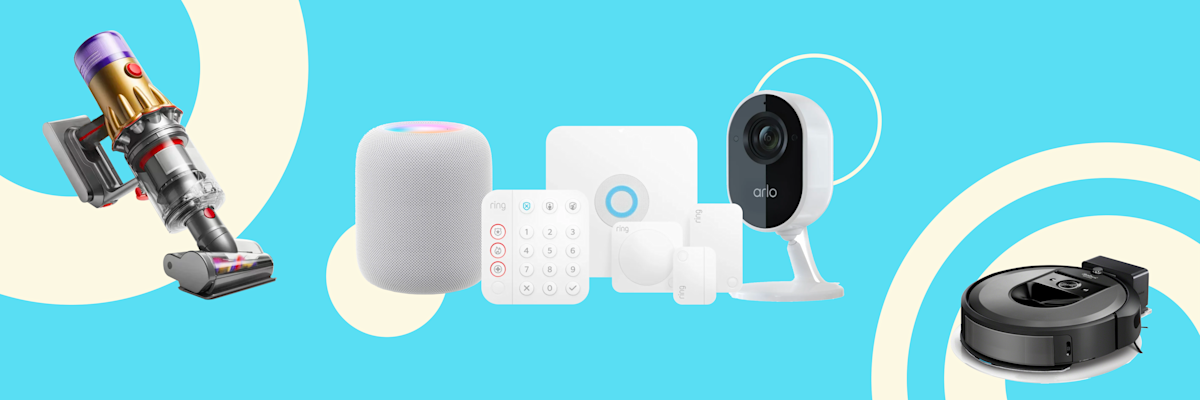12/07/2023
Smart home innovations enable users worldwide to fully enjoy the convenience of modern living, whether optimizing cost efficiency with a smart thermostat, setting up a vacuum robot for quick apartment cleaning when you’re out at work, or having a virtual assistant prepare morning coffee.
However, with all the options and revolutionary technology out there, navigating your way through the multitude of smart home systems and innovations can be slightly overwhelming. To simplify things, we've put together a smart home guide to help you get to grips with some of the alternatives available, highlight a few common sense steps to follow before making a purchase, and generally make the whole process of investing in and setting up smart home technology that little bit easier.
What is the use of a smart home?
A smart home, in a nutshell, is a residence equipped with devices and systems that can be controlled remotely, automated, and interact with each other through a central hub. Their primary purpose is to optimize convenience, efficiency, security, and energy conservation for its users.
When setting up a smart home, convenience is more than just a buzzword; it’s really the central idea behind the technology’s widespread appeal. Convenience means having the ability to control various smart home features such as smart lighting, smart doorbells, smart locks, smart gardening and other systems with minimal effort, usually through a centralized app on a smartphone or with voice commands.
Compatibility comes first
It should be pointed out that while the three main smart home systems (Google Home, Amazon Alexa, and Apple HomeKit) are compatible with both iOs and Android devices, other systems may not be supported. It’s therefore important to carry out the appropriate research beforehand to avoid doing the smart home equivalent of buying Nescafe® pods for a Nespresso® machine.
If you already know the kind of technology that you would like for your home but are unsure about which operating system to go for, a good idea would be to check your favorite products’ compatibility beforehand. For example, when it comes to smart cleaning, the iRobot® Roomba HOME App is designed for use on iOS devices running OS 13 or higher and Android devices running OS 7.0 or higher. It is not compatible with desktop operating systems, Windows Mobile OS or Kindle tablets/Fire OS. In such cases, a quick search on the internet can go a long way.
Once you get past the basics, it’s also worth thinking about which system is most compatible with your specific needs and the exact kind of technology that you prefer to use. For example, if you’re currently reading this on your Mac, iPhone, iPad, it probably makes more sense to invest in the Apple HomeKit and associated products ahead of any other smart home system.

Suggested devices
As we touched on earlier, when setting up a smart home, the wide range of systems and devices available from online brands can often make it difficult to know where to start. With this in mind, we’ve put together a list of some of the most popular innovations that you might consider as you look to get your smart home up and running.
Voice assistant hub
A voice assistant hub makes it possible to play music, brighten or dim lighting in a room, adjust the air conditioning or heating to save energy, and much more—all via voice command. Many of these functions have been around for a while, but modern smart homes allow you to get much more creative by bringing everything together.
On this last point, the fact that many voice assistant hubs such as the Apple HomePod support automation makes it possible to set up routines or scenarios where multiple devices work together based on specific triggers or schedules. For example, you can program a routine that tells the system to turn up the lights, adjust your thermostat and start brewing your coffee at a certain time, or as a reaction to the command “help wake me up”. Routines like these can be set up in a matter of minutes directly from your smartphone.
Smart gardening
It might be difficult to imagine at first, but smart devices and sensors can be used in order to optimize overall garden care for maximum efficiency and sustainability.
For example, data from smart gardening systems can be used to adjust watering schedules, such as in cases of extended periods without rain; protect plants from extreme weather, and control garden lighting depending on the number of daylight hours throughout the year. On top of this, by integrating smart gardening technology with your voice assistant, users can control and monitor their garden using voice commands, like asking the system to water the plants or check the soil moisture levels.
Smart home security
Items such as smart locks provide users with secure and flexible access to their home. As in the case of other smart home innovations, this can be achieved through a series of voice commands and even fingerprint access. Smart doorbells offer a visual and communicative layer of security by enabling you to see and interact with visitors from your phone or smart displays. Again, integration with other devices such motion sensors, alerts, and video recording capabilities allows you to build a comprehensive security system that’s easy to maintain.
Items such as smart locks provide users with secure and flexible access to their home. As in the case of other smart home innovations, this can be achieved through a series of voice commands and even fingerprint access. Smart doorbells offer a visual and communicative layer of security by enabling you to see and interact with visitors from your phone or smart displays.
As always, compatibility is key. For instance, the 5-Piece Ring Alarm Security Kit is equipped with a base station, contact sensor, keypad, range extender, and motion detector. Its integration with other devices, like the Eufycam 3 (S330), enables you to establish a comprehensive security system with video recording capabilities that is easy to maintain through Amazon Alexa or Google Assistant.
When it comes to installation, most of these systems are relatively straightforward to get going. Some require low-voltage wiring, while others operate on battery power, enabling a quick and easy setup. Indoor and outdoor security cameras use sensors to detect and capture motion and sound events, with some indoor cameras offering motorized components for a 360-degree view and options for local or cloud storage. On top of this, some models can be additionally enhanced with optional professional alarm monitoring plans connected to your security system. Such features will guarantee that your system stays on during power cuts and provide 24/7 emergency police, fire and medical response to your home.
With an incredible range of technology and the speed that it’s developing at, it’s clear that smart homes promise a future where living spaces are more intuitive, responsive, and tailored to individual lifestyles. However, embracing these innovations and making the right choice for you requires a considerable amount of research, with a special emphasis placed on compatibility and ease of installation.
Ready to get started?



